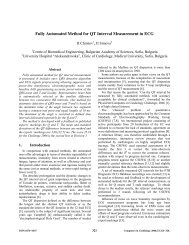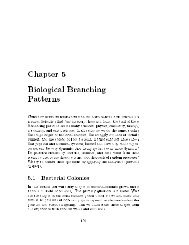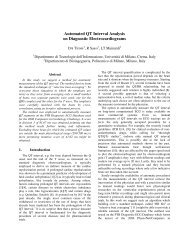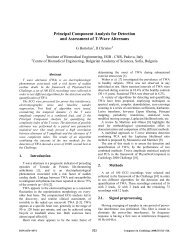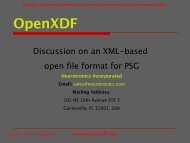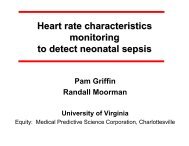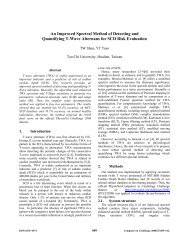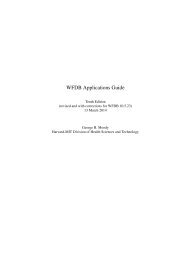T-Wave Alternans And Risk Stratification For Sudden - PhysioNet
T-Wave Alternans And Risk Stratification For Sudden - PhysioNet
T-Wave Alternans And Risk Stratification For Sudden - PhysioNet
- No tags were found...
Create successful ePaper yourself
Turn your PDF publications into a flip-book with our unique Google optimized e-Paper software.
T-<strong>Wave</strong> <strong>Alternans</strong> and <strong>Risk</strong><strong>Stratification</strong> for <strong>Sudden</strong> Cardiac DeathRichard L. Verrier, Ph.D., F.A.C.C.Associate Professor of MedicineHarvard Medical SchoolCardiology DivisionBeth Israel Deaconess Medical CenterDisclosure: Inventor with Dr. Bruce Nearingof the Modified Moving Average method for TWA analysislicensed by GE Healthcare
Objectives• <strong>Sudden</strong> cardiac death: scope and riskstratification challenge• TWA: definition and clinical presentation• Scientific underpinnings of TWA testing• Methodologies for TWA assessment• Clinical evidence of TWA’s utility• Future directions
Scope and Characteristicsof <strong>Sudden</strong> Death Problem• 350,000 deaths/year• In 20-30%, SCD is first manifestation• Electrical event, VF in 85% of cases• Due to interaction between trigger (e.g.,exercise stress, circadian factors) andvulnerable myocardial substrate (MI,myopathy, heart failure)
Huikuri &MyerburgNEJM 2001<strong>Sudden</strong> Death in Specific Populations
Critical Roleof Autonomic Triggers• Circadian pattern of MI and sudden death• Efficacy of beta-blockade in preventingsudden death• Physical and mental stress are associated withMI and SCD risk• Increased risk with depressed HRV and BRS
Circadian Variation of <strong>Sudden</strong> Cardiac DeathN=2,203 persons who died suddenly in Massachusetts during 1983Number of Deaths140120100806040200Midnight 6:00 AM Noon 6:00 PMMuller et al Circulation 1987
Secondary Prevention of SCD with MetoprololOlsson et al Eur Heart J 1992
Patients at <strong>Risk</strong>for Nocturnal Cardiac EventsCADHeart failureApnea (2-4% of adults)Brugada and LQT320% MIs, 15% SCD20% SCDMajor comorbid factorSCD more prevalent atnightVerrier & Josephson Principles of Sleep Medicine 2005
Requirementsof <strong>Sudden</strong> Death <strong>Risk</strong> Stratifiers• Sensitive to autonomic triggers (HRV, BRS)• Capable of detecting electrical instability ofmyocardial substrate (TWA)• Can be monitored during exercise and dailyactivities (ambulatory ECG)
Why TWA?• Reflects a quantifiable, fundamentalelectrophysiologic property linked to VF.• Compatible with exercise and ambulatoryECG monitoring– Thus, can expose latent electrical instability
TWA DefinitionRepeating ABAB patternin amplitude and shape of T wave
Pathologic States with TWA• Long QT Syndrome• Myocardial Ischemia and Infarction• Cardiomyopathies• Heart Failure• ICD Patients• EP Patient Population• <strong>Sudden</strong> Infant Death Syndrome• Drug-Induced Torsade de Pointes
TWA in Patientwith Acute Anterior Wall Myocardial InfarctionVentricular FibrillationPantridge Neural Mechanisms 1978
Progression from TWAto Polymorphic VTRaeder et al N Engl J Med 1992
TWA Detection by GE’s Case 8000 Treadmillwith FDA-approved MMA MethodComputer Processed Data:Superimposed A&B BeatsRaw data:Confirms TWALater, During Recovery:Episode of VTACH• TWA Overlooked Until Computer Detected.GE Medical System’s Physicians Guide to TWA 2005©
Experimental Evidence andMechanisms Linking TWA to VF
TWA Predicts VF:Physiologic Interventions• Increase TWA– Myocardial ischemia– Reperfusion– Sympathetic nerve stimulation– Behavioral arousal– Hypothermia– Rapid pacing (>200 beats/min in normal heart)• Decrease TWA– Sympathectomy– Vagus nerve stimulationVerrier & Nearing JCE 1994
TWA Predicts VF:Pharmacologic Interventions• Decrease TWA– Calcium channel blockade (verapamil,diltiazem, nexopamil)– Beta-adrenergic blockade (metoprolol)– NO Donor (nitroglycerin)– Amiodarone (clinical study)• Increase TWA– Amiodarone prior to TdP onset
Electrophysiologic Basisfor TWA’s Predictive Power• Assesses temporal spatial heterogeneity ofrepolarizationVerrier & Nearing JCE 1994
SpatialHeterogeneityRiseswith IncreasedT-waveComplexityNearing & VerrierJ Appl Physiol 2003
OrderlyProgressionto MultipleT-waveOscillationsNearing & Verrier Circ Res 2002
QuadruplingComplex<strong>For</strong>msCrescendo inT-waveOscillationsPreceding VFTWAT-wave Area0 1 2 3 4 5Min after OcclusionNearing & Verrier Circ Res 2002
Clear and Present Danger
Surge in TWA Provides 20- to 30-Min Warning PeriodPrior to Ventricular TachyarrhythmiasWarning periodTWA (µV)TWA (Tonset to Tpeak)Complex forms (Energy)N = 24 patientsEnergy (µV)TWA analyzedby MMAmethod fromHolterrecordingsShusterman & Goldberg Circulation [abstract] 2004
Ionic Mechanism of TWAAbnormal Intracellular Calcium Handling
Alternationin Action Potentialand CalciumTransientsduring SimulatedIschemiaLee et al Circulation 1988
Clinical Assessment of TWA• Spectral method– Fast Fourier Transform– Exercise• Time-domain– Modified Moving Average– Exercise– Ambulatory ECG monitoring
Spectral Method• Analyzes in frequency domain– TWA occurs at 0.5 cycle/beat• Requires data stationarity for ≥128 beats• Requires specialized electrodes to optimizesignal to noise ratio• 1-microvolt resolution• <strong>Wave</strong>form not provided
Fast Fourier Transform Analysis of TWAVerrier & Cohen Foundations of Cardiac Arrhythmias 2000
Modified Moving Average Method• Analyzes in time domain– Continuous stream of A and B forms• Does not require data stationarity– Reports TWA value per 15 seconds• Standard electrodes• 1-microvolt resolution• TWA template for computer-aidedwaveform inspection
Modified MovingAverage Analysisof T-<strong>Wave</strong> <strong>Alternans</strong>Nearing & Verrier J Appl Physiol 2002
TWATemplateWindowTWA = 80µVAdapted from Verrier et al JCE 2003
Analytical Features of TWA Median TemplateTWA• High-resolution superimposed ECGsfor visual inspection– To rule out false TWA– To evaluate QRS changes– To confirm TWA visually down to~20µV– To determine component of T-wavethat alternates• Potential mechanistic insightsVerrier Heart Rhythm Society 2005
Medians / Templates: A Closer LookBeats A & B Superimposed:.A beat: White. B beat: YellowGreen Arrow: Maximum <strong>Alternans</strong> in BeatsGE Medical Systems’ TWA Physician’s Guide 2005
Medians / Templates: A Closer LookTWA Value / Micro VoltsNoise Value / Micro VoltsGE Medical Systems TWA Physician’s Guide 2005
Arrhythmia <strong>Risk</strong> <strong>Stratification</strong> with TWAHigh-risk groups– EP population:• Rosenbaum 1994, Estes 1997, Gold 2000,Klingenheben 2001, Rashba 2004– ICD patients: Hohnloser 1998– Heart failure: Klingenheben 2000, Bloomfield 2006– Cardiomyopathy: Adachi 1999, Hohnloser 2003,Kitamura 2002, Kon-No 2001, Sakabe 2001• Moderate- to low-risk groups– Post-MI:• Ikeda 2002• Verrier 2003• 18 studies enrolled more than 100 patientsNarayan J Am Coll Cardiol 2006
Ambulatory ECG Tracking of TWAin Post-MI Patients to Assess <strong>Risk</strong>of Cardiac Arrest or Arrhythmic Death:Study Design• Nested case-control with 2:1 matching (15cases, 29 controls) on age (±5 yrs), sex, site ofMI, LVEF (±3%), thrombolysis, betablockade• AECG monitored early (15±10 days) post-MI• Follow-up 21±8 monthsVerrier et al JCE 2003
TWA Analysis and <strong>Risk</strong> <strong>Stratification</strong>• TWA analysis by investigator blinded to outcomes• A priori time points for TWA determinations:– 8:00 a.m.– Maximum heart rate– ST-segment deviation• A priori cutpoint at 75 th percentile of TWA incontrols• Odds ratios estimated as a measure of relative riskwith logistic regression models controlling for allmatching factors
HypothesisPost-MI patients at risk for arrhythmicdeath and cardiac arrest have electricalinstability manifest as T-wave alternans.
AECG TWA and Arrhythmia <strong>Risk</strong>in Post-MI PatientsOdds Ratio of Cardiac Arrestor Death from Arrhythmia9876543210p=0.005Lead V1Lead V5p=0.02p=0.04p=0.04p=0.80p=0.94TWA at max HR TWA at 8 am TWA at max ST devVerrier et al JCE 2003
Exercise- and Mental Stress-InducedTWA in ICD Patients and NormalsD T-wave <strong>Alternans</strong> (mV)2520151050****MentalExerciseExerciseArithmeticStage 1PeakNormal, HR = 81±3 102±4 124±3ICD = 81±4 96±5 121±5NSKop et al Circulation 2004
Elevated TWA in Patients with Stable CADduring Routine Treadmill TestingNearing, Stone & Verrier J Am Coll Cardiol 2004
Summary and Conclusions• TWA reflects fundamental property linkedto risk for VF• Can be quantified during routine clinicaltesting, including exercise and AECGs• Useful in sudden death risk stratification• May help to guide therapy
Future of TWA• Multiparameter analysis– Autonomic function (HRV, BRS/HRT)– Cardiac electrical function (TWA)• Multiple platforms
Future Platforms for TWA• Exercise treadmill or ergometry• Holter and in-hospital monitoring• EP laboratory programmed stimulation– TWA magnitude and phase reversal• ICDs:– TWA is harbinger of VF– Signal to initiate urgent therapy• Alert central monitoring stationVerrier ISHNE 2005
Selected References• Nearing BD, Huang AH, Verrier RL. Dynamic tracking of cardiac vulnerability by complexdemodulation of the T-wave. Science 1991;252:437-40.• Nearing BD, Verrier RL. Modified moving average method for T-wave alternans analysis with highaccuracy to predict ventricular fibrillation. J Appl Physiol 2002;92:541-549.• Nearing BD, Verrier RL. Progressive increases in complexity of T-wave oscillations herald ischemiainducedVF. Circ Res 2002;91:727-732.• Verrier RL, Nearing BD, LaRovere MT, Pinna GD, Mittleman MA, Bigger JT, Schwartz PJ for theATRAMI Investigators. Ambulatory ECG-based tracking of T-wave alternans in post-myocardialinfarction patients to assess risk of cardiac arrest or arrhythmic death. J Cardiovasc Electrophysiol2003;14:705-711.• Kop WJ, Krantz DS, Nearing BD, Gottdiener JS, Quigley JF, O’Callahan M, Delnegro AA, FriehlingTD, Karasik P, Suchday S, Levine J, Verrier RL. Effects of acute mental and exercise stress on T-wave alternans in patients with implantable cardioverter defibrillators and controls. Circulation2004;109:1864-1869.• Verrier RL, Josephson ME. Cardiac arrhythmogenesis during sleep: mechanisms, diagnosis, andtherapy. In: Kryger MH, Roth T, Dement WC, editors. Principles and Practice of Sleep Medicine, 4 thedition. Philadelphia: WB Saunders, 2005:1171-1179.• Verrier RL, Nearing BD, Kwaku KF. Noninvasive sudden death risk stratification by ambulatoryECG-based T-wave alternans analysis: evidence and methodological guidelines. Annals ofNoninvasive Electrocardiology 2005;10:110-120.• Bloomfield DM, Bigger JT, Steinman RC, Namerow PB, Parides MK, Curtis AB, Kaufman ES,Davidenko JM, Shinn TS, Fontaine JM. Microvolt T-wave alternans and the risk of death or sustainedventricular arrhythmias in patients with left ventricular dysfunction. J Am Coll Cardiol 2006;47:456-63.• Narayan SM. T-wave alternans and the susceptibility to ventricular arrhythmias. J Am Coll Cardiol2006;47:269-81.




